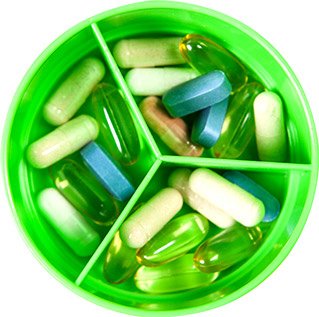
Do Diet Pills Work?
Here's a look at some of the most common weight-loss ingredients—and what they will and won't do for you.
The basics for fat loss are pretty simple: Eat a little less and move a little more. It's a simple concept that's been around for ages— yet we still search for that magic pill that will make our fat-loss dreams come true.
You can drastically change your body composition from diet and exercise alone. If you're skipping these important steps to look for a quick fix, chances are you're going to be disappointed. Fat-loss supplements are a tiny percentage of the equation, and should be treated as such. If you're taking a fat-loss supplement that helps burn an extra 80 calories per day, but you're consuming an extra 500 calories a day in muffins and lattes, it's time for a shift in focus.
Not every diet pill is the same, needless to say. Some of the ingredients work, and some aren't worth giving a second glance. Learn some of the common ingredients found in diet pills, and what may actually help in your fat-loss efforts.
Stimulants
Claims: Burn more fat, increase metabolism, or melt away fat
Common Ingredients: Caffeine, green tea extract, green coffee extract, guarana
How They Work
People looking for a little extra help with their weight-loss efforts often turn to stimulants, which may help increase calorie burn and provide a boost of energy during workouts.
Caffeine is the world's most common stimulant, so it's no surprise that it's found in almost every type of diet pill. Research supports its ability to increase rates of fat burning while also allowing your body to use more fat, rather than carbohydrates. Caffeine also has a short-term effect on resting metabolism.1
The ergogenic effect of caffeine is strongly linked to habitual caffeine consumption. If you're going through pots of coffee a day, you may not see any additional benefit from supplementation.

Green tea extract has also been shown to aid weight loss by increasing fat oxidation and metabolism.2,3 Just make sure to pay attention to the amount of epigallocatechin gallate, (EGCG) in the product. EGCG is the active antioxidant in green tea and responsible for its fat-burning properties.
Another popular ingredient, green coffee extract, comes from coffee beans that have not yet been roasted. These beans contains higher levels of chlorogenic acid compared to regular roasted coffee beans, and are believed to help aid weight loss by preventing carbohydrate uptake from the intestines after a meal. Although generally safe for use in healthy individuals, its benefits do not appear to be as potent as ingredients such as caffeine and EGCG.
Guarana comes from the seeds of a fruit-bearing tree, and is used primarily for it stimulant properties as well as its ability to increase fat oxidation. Guarana contains a high level of caffeine. However, because a majority of the research has been done in animal models, it's difficult to say if guarana aids weight loss in humans.4
Possible Side Effects
Stimulants can cause increased heart rate, dizziness, trouble falling asleep, nausea, and make you feel jittery.
Suggested Dosage
200-400 mg of caffeine, 600 mg EGCG, 600-1,500 mg of green coffee extract (containing 200 mg of chlorogenic acid), 50-75 mg of guarana
Appetite Suppressants
Claims: Curb appetite, kill hunger pangs, and keep you feeling full off fewer calories
Common Ingredients: Hoodia, yerba mate, chromium picolinate
How They Work
Appetite suppressants are designed to help you ward off cravings, promote normal appetite levels, and support your weight-loss goals. In addition to caffeine, there are several other ingredients that claim to help blunt hunger signals while giving you better energy levels and increasing your metabolism.
Hoodia gordonii, a small plant traditionally used by various indigenous hunter-gatherer people of southern Africa as an appetite suppressant to help them survive harsh desert conditions, has made its way into the weight-loss market. In theory, this plant would work wonders in a diet pill, but the majority of hoodia's research on appetite suppression has been conducted on rats.5-7 Between the unsupported effects in humans and the unknown toxic effects, there's just not enough data yet to support its use.8
Yerba mate is another herbal stimulant commonly found in tea and pill form. It claims to work by forcing your stomach to retain food longer, making you feel full for a longer period of time after eating.
Chromium picolinate claims to decrease appetite, burn more calories, drop body fat, and boost muscle mass. Despite promising claims blown out of proportion by the media, there's no substantial evidence supporting its effect on body composition.9,10
Possible Side Effects
Chromium can cause GI issues like gas, bloating, and diarrhea, as well as heart arrhythmias and seizures. Insomnia, irritability, and headaches have also been reported with chromium picolinate and yerba mate.
Suggested Dosage
The research on appetite suppression is weak. To date, there's no single ingredient found in common weight-loss supplements or fat burners that will suppress appetite at a given dose without causing potential negative side effects. Additionally, Yerba Mate has repeatedly been associated with upper-digestive-tract cancers. Although the severity of the association is somewhat weak, it is worth noting.

Laxatives
Claims: Flush fat off the body, cleanse your body of toxins
Common Ingredients: Cascara, senna, psyllium
How They Work
In a sense, most of these fibers interact with the intestinal tract to improve intestinal motility and increase the frequency or quality of bowel movements. Psyllium is able to bind to fatty acids and cholesterol from the diet, and is thought to be a gentler laxative than senna and cascara.
Due to laxatives' limited effect on weight loss, taking them is not recommended unless you are experiencing constipation and consequential intestinal discomfort or pain. Additionally, it is recommended that these be taken for no longer than 7 days.
Possible Side Effects
Besides the obvious—having to spend the day glued to the toilet—the use of laxatives can also cause dehydration and GI distress.
Suggested Dosage
1-2 g of senna (standardized to 10-30 mg of active sennosides), 5 g of psyllium taken 3 times a day, 325 mg of cascara
Other Popular Weight-Loss Ingredients
Chitosan, guar gum
These ingredients are touted for their ability to block the absorption of fats and cholesterol. Although chitosan has been shown to have a small effect on fat absorption, these effects are negligible, leaving claims of weight loss unsubstantiated.11,12 Possible side effects include upset stomach and GI distress
Conjugated linoleic acid (CLA)
Supposedly, CLA helps you lose body fat and increase muscle mass. This ingredient is a regular in weight-loss supplements, although evidence from long-term trials (mostly done in obese individuals) suggests the effects are minimal at best.13-15 Suggested doses fall in the range of 3,200-6,400 milligrams daily. I strongly recommend taking it with meals to avoid an upset stomach, nausea, and loose stools.
7-keto DHEA
7-keto DHEA is said to help boost metabolism so you burn more calories throughout the day. Studies do exist indicating 7-keto-DHEA may be effective as a weight-loss aid in normal and overweight adults.16,17 It has been reported that 200 milligrams of supplementation can aid in attenuating the decrease in RMR associated with caloric restriction, in addition to weight loss and a decrease in body fat.
Raspberry ketones
This chemical that comes from—you guessed it, raspberries—shows some promise of lipolysis and fatty-acid oxidation at the molecular level, but there is no human data to support just yet.18 Translating the dose used in animal studies to human levels leads to an extremely high dose (anywhere from 90-300 milligrams per kilogram of body weight).19
Garcinia cambogia
A small fruit usually used in cooking, garcinia cambogia is a good source of hydroxycitric acid (HCA), which is purported to aid weight loss. We're starting to see a trend here; supplementation shows promise in animal-model research, but human studies are variable at best, with mixed results in weight loss. Some studies show a small benefit (around 3 pounds over 3 months), but others show no benefit at all.20-22 As with raspberry ketones, the daily doses used in human research (>1000 milligrams) are substantial.

Yohimbine
Yohimbine is said to increase testosterone levels and aid fat loss. Research on yohimbine and weight loss is relatively inconclusive, although doses of 0.2 milligrams per kilogram of body weight have been shown to improve fat loss.23 Because yohimbine works by increasing adrenaline levels in the body, side effects may include elevated heart rate and anxiety.
Two Ingredients to Avoid
While it's always a good idea to consult with your physician before taking any of the ingredients listed above, there are two you should use with extreme caution. Bitter orange—which contains synephrine, an ingredient related to ephedra—can be dangerous for people with heart conditions, since it tends to raise blood pressure.
Additionally, ephedra (aka ma huang) has been banned by the FDA since it was linked to serious side effects including heart attack, arrhythmia, stroke, seizures, and death.
There's no shortcut to quality, sustained body-composition improvements. You can jam all the supplements you want down your throat, but unless you're training appropriately and paying attention to your dietary choices, you're literally throwing away your money. Some of these ingredients may complement your fitness efforts, but they won't replace them!
References
- Jeukendrup, A. E., & Randell, R. (2011). Fat burners: nutrition supplements that increase fat metabolism. Obesity Reviews, 12(10), 841-851.
- Maki, K. C., Reeves, M. S., Farmer, M., Yasunaga, K., Matsuo, N., Katsuragi, Y., ... & Cartwright, Y. (2009). Green tea catechin consumption enhances exercise-induced abdominal fat loss in overweight and obese adults. The Journal of Nutrition, 139(2), 264-270.
- Roberts, J. D., Roberts, M. G., Tarpey, M. D., Weekes, J. C., & Thomas, C. H. (2015). The effect of a decaffeinated green tea extract formula on fat oxidation, body composition and exercise performance. Journal of the International Society of Sports Nutrition, 12(1), 1.
- Lima, W. P., Carnevali, L. C., Eder, R., Rosa, L. F. B. C., Bacchi, E. M., & Seelaender, M. C. (2005). Lipid metabolism in trained rats: effect of guarana (Paullinia cupana Mart.) supplementation. Clinical Nutrition, 24(6), 1019-1028.
- van Heerden, F. R., Horak, R. M., Maharaj, V. J., Vleggaar, R., Senabe, J. V., & Gunning, P. J. (2007). An appetite suppressant from Hoodia species. Phytochemistry, 6(20), 2545-2553.
- Smith, C., & Krygsman, A. (2014). Hoodia gordonii: To eat, or not to eat. Journal of Ethnopharmacology, 155(2), 987-991.
- Smith, C., & Krygsman, A. (2014). Hoodia gordonii extract targets both adipose and muscle tissue to achieve weight loss in rats. Journal of Ethnopharmacology, 155(2), 1284-1290.
- Lee, R. A., & Balick, M. J. (2007). Indigenous use of Hoodia gordonii and appetite suppression. Explore: The Journal of Science and Healing, 3(4), 404-406.
- Vincent, J. B. (2003). The potential value and toxicity of chromium picolinate as a nutritional supplement, weight loss agent and muscle development agent. Sports Medicine, 33(3), 213-230.
- Lukaski, H. C., Siders, W. A., & Penland, J. G. (2007). Chromium picolinate supplementation in women: effects on body weight, composition, and iron status. Nutrition, 23(3), 187-195.
- Gades, M. D., & Stern, J. S. (2003). Chitosan supplementation and fecal fat excretion in men. Obesity Research, 11(5), 683-688.
- Gades, M. D., & Stern, J. S. (2005). Chitosan supplementation and fat absorption in men and women. Journal of the American Dietetic Association, 105(1), 72-77.
- Kamphuis, M. M., Lejeune, M. P., Saris, W. H., & Westerterp-Plantenga, M. S. (2003). The effect of conjugated linoleic acid supplementation after weight loss on body weight regain, body composition, and resting metabolic rate in overweight subjects. International Journal of Obesity, 27(7), 840-847.
- Kreider, R. B., Ferreira, M. P., Greenwood, M., Wilson, M., & Almada, A. L. (2002). Effects of conjugated linoleic acid supplementation during resistance training on body composition, bone density, strength, and selected hematological markers. The Journal of Strength & Conditioning Research, 16(3), 325-334.
- Chen, S. C., Lin, Y. H., Huang, H. P., Hsu, W. L., Houng, J. Y., & Huang, C. K. (2012). Effect of conjugated linoleic acid supplementation on weight loss and body fat composition in a Chinese population. Nutrition, 28(5), 559-565.
- Zenk, J. L., Frestedt, J. L., & Kuskowski, M. A. (2007). HUM5007, a novel combination of thermogenic compounds, and 3-acetyl-7-oxo-dehydroepiandrosterone: each increases the resting metabolic rate of overweight adults. The Journal of Nutritional Biochemistry, 18(9), 629-634.
- Kaiman, D. S., Colker, C. M., Swain, M. A., Torina, G. C., & Shi, Q. (2000). A randomized, double-blind, placebo-controlled study of 3-acetyl-7-oxo-dehydroepiandrosterone in healthy overweight adults. Current Therapeutic Research, 61(7), 435-442.
- Park, K. S. (2010). Raspberry ketone increases both lipolysis and fatty acid oxidation in 3T3-L1 adipocytes. Planta Medica, 76(15), 1654.
- Morimoto, C., Satoh, Y., Hara, M., Inoue, S., Tsujita, T., & Okuda, H. (2005). Anti-obese action of raspberry ketone. Life Sciences, 77(2), 194-204.
- Heymsfield, S. B., Allison, D. B., Vasselli, J. R., Pietrobelli, A., Greenfield, D., & Nunez, C. (1998). Garcinia cambogia (hydroxycitric acid) as a potential antiobesity agent: a randomized controlled trial. JAMA, 280(18), 1596-1600.
- Kim, J. E., Jeon, S. M., Park, K. H., Lee, W. S., Jeong, T. S., McGregor, R. A., & Choi, M. S. (2011). Does Glycine max leaves or Garcinia Cambogia promote weight-loss or lower plasma cholesterol in overweight individuals: a randomized control trial. Journal of Nutrition, 10(1), 94.
- Vasques, C. A., Schneider, R., Klein?Júnior, L. C., Falavigna, A., Piazza, I., & Rossetto, S. (2014). Hypolipemic Effect of Garcinia cambogia in Obese Women. Phytotherapy Research, 28(6), 887-891.
- Ostojic, S. M. (2006). Yohimbine: the effects on body composition and exercise performance in soccer players. Research in Sports Medicine, 14(4), 289-299.



